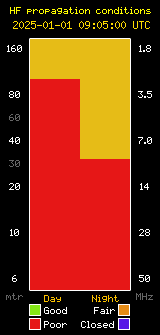Well, last Thursday night’s net (4/16/15) was yet another successful one with 11 check-ins plus net control (K6HWN). The net began with Garrett (AG6RQ) asking what the difference is between an antenna tuner and a matching network is. John (A6GLJ) was the first one to respond with the fact that what an antenna tuner really does is when it’s placed between the coax and transceiver it keeps the transceiver happy with the SWR level so it can deliver the maxim power to the load (antenna). If the transceiver detects too high of an SWR level it will restrict the amount of power output as to not damage the final amplifier stage. Cyril (AF6GW) offered up that maybe if the tuner was placed between the coax and the antenna it would be more of at true antenna tuner. Dave (K6HWN) agreed with Cyril except that it might be called an antenna impedance compensator, which is really what it does by changing the length of the antenna or the matching point. Cyril made a point that sure, the tuner might make the transmitter happy but the fact is that you still have the same feed line loss or bad antenna paring.
Don’t you wish you had tuned in? If so you can listen to the audio archive here.
John (AG6LJ) mentioned that this topic is one of the issues they’re currently dealing with using the fractional wave loop antennas. They’re really not designed to work on 12 meters, they can go with a solid state amplifier to about 200 watts, however with the impedance matcher/antenna tuner they can run full legal power. It basically tricks the system into working yet it’s not fully efficient but you can get the power out and at end of the day it works. Also discussed at this point was the concept of grid dipping in historical tube amps, and reversing the leads on an SWR meter to ascertain reflected power going back to the transceiver. (You can review the audio here).
Next Levi (K6LCM) had some follow-up regarding his attempt to use a Heil adapter to connect a headset with a boom mic and headphones to his rig. He was having trouble getting audio to the radio. (Solution can be heard here).
Now Cyril had some follow-up to a previous net’s question regarding suitable coating material for antennas, wires, enclosures, etc., that won’t affect the performance of the antenna. (Audio answer can be heard here).
Wish you’d been listening? Go here.
Lastly, I (K6FLD) posed a question regarding a strange hum or resonating I’ve been hearing in the walls or other source in my house using a new antenna. I purchased an end-fed antenna and on certain band frequencies I would hear a curious hum, seemingly coming from the walls of my home (at least that was my perception) when keying down the mic. On other band frequencies there was no discernible noise. Weird. So I purchased an MFJ-969 antenna tuner thinking that by properly matching the impedance at my rig it would eliminate the interference. Well, the other night I heard it again. A question was asked by Hayden (KK6OYV) if my station had an RF ground or not. My shack is on the second floor of my house with a deck and another 10 ft. drop impeding a short ground solution, so the answer was a resounding NO. Dave (K6HWN) mentioned the possible use of an artificial ground solution such as the MFJ-931. What the heck is that I asked??? Well, it turns out that if you connect the device between your rig and feed line or antenna tuner and feed line it reduces the electrical length of the ground connection wire to virtually zero by tuning out its reactance. Stay tuned to future nets to learn if I can solve my grounding issue!
Tune in to the SBARC Technical Mentoring and Elmering Net every Thursday night at 0800 on 146.79 and see what interesting questions will arise or ask some of your own! All club members and visitors are encouraged to check in to the Technical Mentoring and Elmering net each week and join in with questions and /or answers to and contribute the knowledge of new and seasoned amateur radio operators alike.









